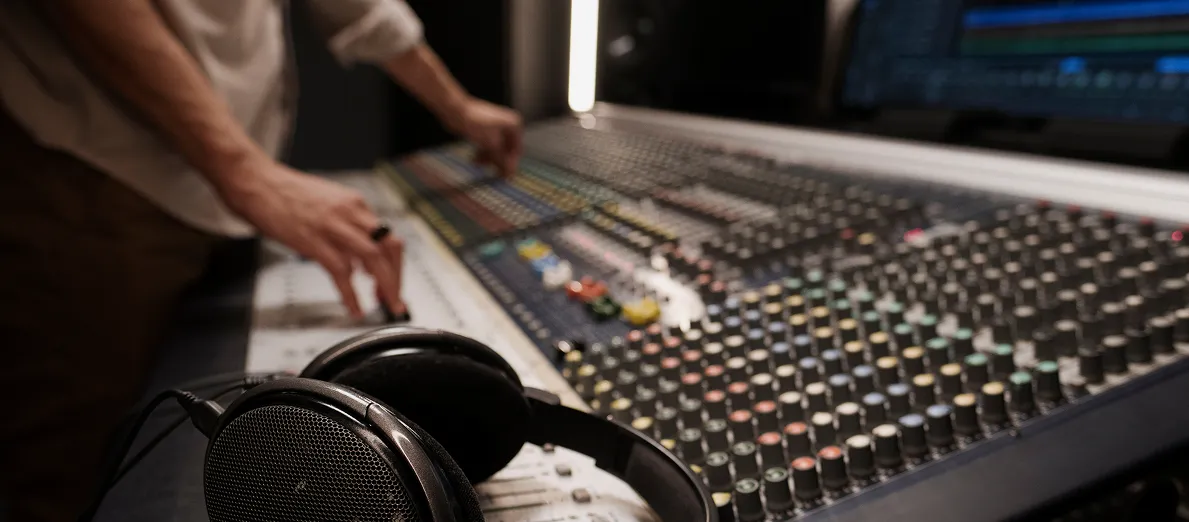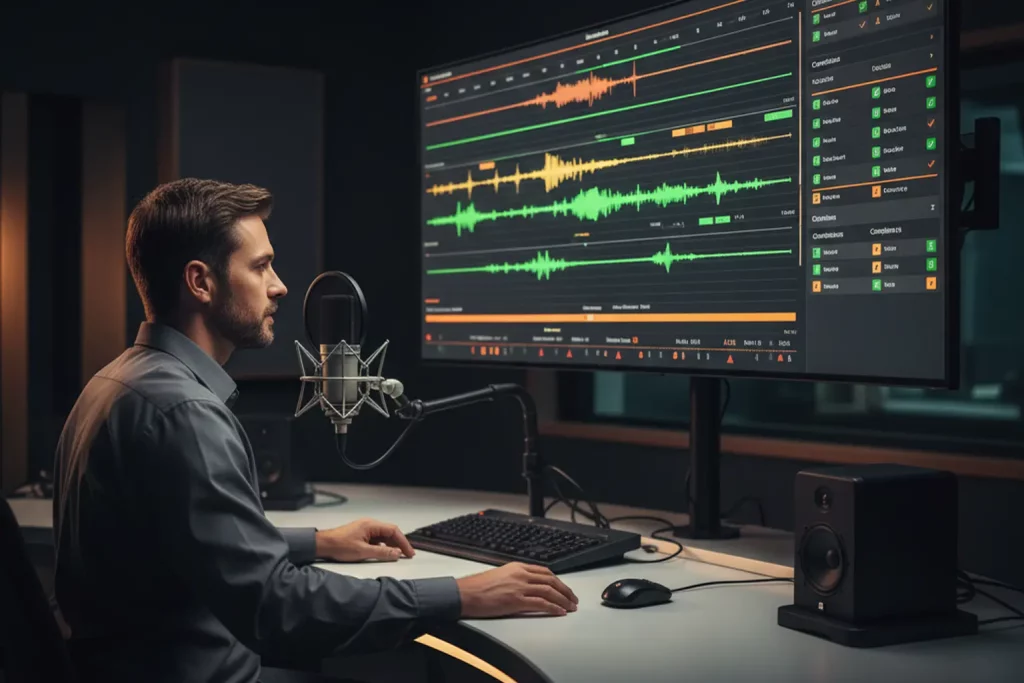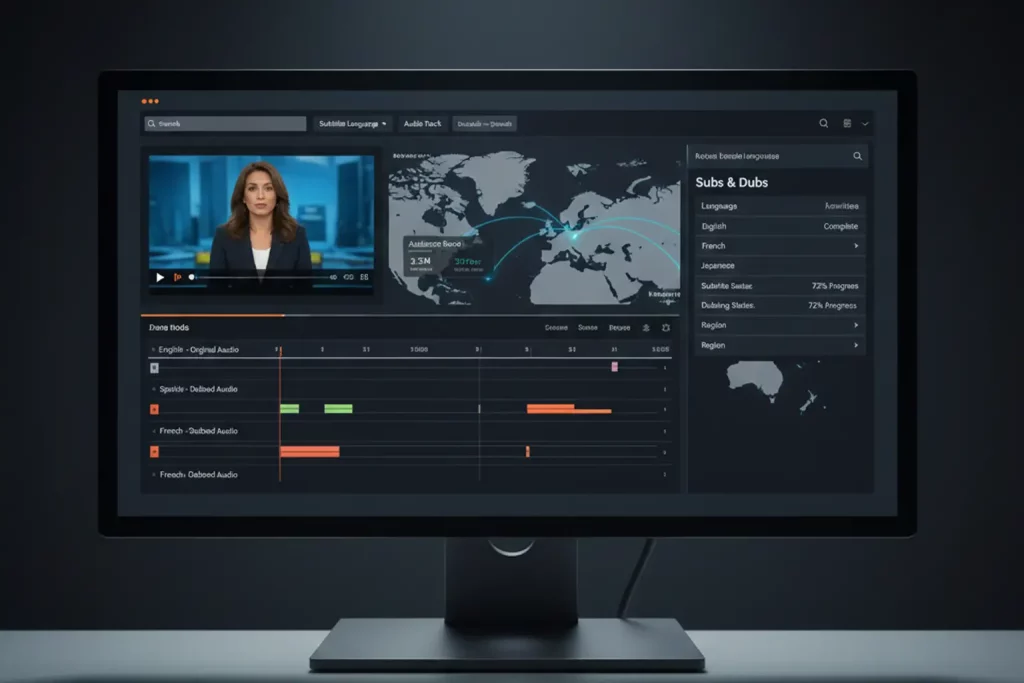Loudness meters keep viewers from lunging for the remote during commercial breaks. U.S. broadcasters aim for minus 24 LKFS while streamers sit near minus 14 LUFS. Overshoots trigger CALM Act fines and viewer churn. Audio teams track momentary, short‑term, and integrated loudness in real time. Automation flags any segment that rises two LU above spec and routes it back for repair. Effective loudness monitoring preserves creative intent, protects hearing, and maintains brand trust across every screen.
Keep reading to see which metrics matter, how to meet global regulations, and which tools deliver rock‑solid compliance without draining headcount.
Understanding Loudness vs. Volume
Many engineers still treat loudness and volume as twins, yet the two metrics differ in crucial ways. Loudness reflects how human ears perceive sound over time, while volume shows the electrical strength that speakers emit. When you mix without this distinction you risk clipping dialogue or burying ambience. The next subsections break down the science so you can plot levels with confidence.
Defining Loudness and Perceived Sound
Listeners judge loudness with the brain, ear, and environment acting together. Engineers express that perception in loudness units relative to full scale, or LUFS. The scale averages energy across frequency bands using a K‑weighted filter that mimics human sensitivity. Because hearing peaks near 2 to 4 kHz, LUFS assigns more weight there than at the extremes. By aligning mixes to a fixed LUFS target you deliver consistent perceived intensity even if absolute volumes differ.
Why Volume Isn’t Loudness
Volume meters show electrical amplitude, not listener comfort. A gunshot and a sustained violin can share the same dBFS value, yet the violin feels quieter because the energy spreads over time. Loudness meters integrate exposure and apply psychoacoustic weighting, so the gunshot scores higher. When teams rely only on volume they over‑compress music beds and under‑power speech. Swapping to loudness meters removes that guesswork and stops the late‑night volume roller coaster.
Key Loudness Metrics and Standards
Standards bodies turned the fuzzy concept of loudness into math that every encoder can obey. This section covers the metrics and how broadcasters use them inside specs and service level agreements.
LUFS / LKFS Explained
Both LUFS and LKFS mean Loudness Units relative to Full Scale, but LKFS appears in U.S. documents while LUFS rules Europe and streaming specs. Engineers calculate an integrated value across the full program, then check momentary and short‑term windows for spikes. One LU equals one dB, so the scale feels intuitive. For broadcast, the target usually sits at minus 24, with a tolerance of plus or minus two. Streamers shift closer to minus 14 to help mobile listeners competing with street noise.
RMS and Peak Level Comparisons
Root‑mean‑square meters average squared sample values and ignore psychoacoustics. They work well for measuring power‑supply stress but fail at predicting listener perception. Peak meters catch transient overs but provide no context for sustained loudness. By pairing LUFS with true peak readings you stop both clipping and loudness drift. A common spec sets minus 1 dBTP as the ceiling and expects engineers to shape dynamics below that line.
Momentary, Short‑term, Integrated Measurements
Momentary loudness captures a 400‑millisecond window, short‑term uses three seconds, and integration spans the entire program. Each view tells a different story. Momentary spots fast spikes like door slams, short‑term reveals section‑to‑section balance, and integrated confirms overall compliance. Operators monitor all three to catch issues before playout. Modern meters plot these values together so teams can see context at a glance.
How Digital Nirvana Simplifies Loudness Compliance
Our services at Digital Nirvana put loudness compliance on autopilot. MonitorIQ records and analyzes every channel in real time, issuing actionable alerts before a CALM Act breach can occur. For post‑production and archiving, MetadataIQ auto‑tags loudness metrics alongside transcripts, so editors spot issues directly inside their PAM interface. Teams add captions through TranceIQ in the same workspace, ensuring all deliverables remain synced and accessible. Together these tools cut manual QC hours by half, reduce re‑mixes, and bring instant visibility to any loudness drift. Broadcasters gain compliance peace of mind without adding headcount.
Regulations in Broadcasting
Governments and industry groups wrote rules after years of viewer complaints about blaring commercials. Ignore them and fines stack up fast. This section outlines the key mandates.
ATSC A/85 and CALM Act (US Standards)
Congress passed the Commercial Advertisement Loudness Mitigation Act to stop jarring volume jumps. ATSC A/85 gives the technical recipe: target minus 24 LKFS, plus or minus two. Stations must apply the spec to both programming and ads, measured with ITU‑BS.1770 algorithms. The FCC consumer guide on loud commercials explains viewer rights and station duties in plain language. The FCC can levy penalties for every violation day, so broadcasters bake loudness checks into automation instead of risking manual slipups.
EBU R128 in Europe
The European Broadcasting Union issued R128 with a minus 23 LUFS target and a 0 LU tolerance. This spec also defines maximum true peak at minus 1 dBTP. Countries such as Germany embedded R128 into law, while the U.K. enforces it through distributor contracts. R128 adds a Loudness Range metric so mixers keep dynamics engaging yet controlled. European content that meets R128 travels smoothly to global platforms.
Netflix and Streaming Loudness Specs
Streaming giants set their own targets to balance mobile playback and living‑room setups. Netflix asks for minus 27 LKFS dialog‑gated with a minus 2 dBTP peak. Spotify, YouTube, and Apple Music hover near minus 14 LUFS with varying peaks. A proposed CALM Modernization Act aims to extend loudness rules to ad‑supported streaming, signaling stricter oversight ahead. Hitting each platform’s stated loudness avoids re‑encoding that can crunch transients or elevate noise.
Loudness Monitoring Tools & Measurement
Meters shape behavior. Pick the right tool and compliance becomes routine. These subsections survey the major categories and link to deeper guides such as our AI metadata tagging article for workflow tips.
Loudness Meters vs. Peak/VU Meters
Loudness meters calculate LUFS in real time and show momentary, short‑term, and integrated tracks. Peak meters display instantaneous sample maxima, while classic VU meters average slower and correlate with perceived loudness only loosely. Engineers run all three because each covers a blind spot. Loudness units catch long‑form balance, peak meters guard against clipping, and VU meters reveal midrange punch. Multimeter plugins combine them so mixers never flip between windows; MonitorIQ stitches these readings into a single compliance dashboard.
Gating and Equal‑loudness Contours
ITU‑BS.1770 gates silence below minus 70 LUFS to stop quiet stretches from skewing integrated results. The standard also applies K‑weighting, which tilts response toward frequencies our ears find painful. These equal‑loudness contours ensure 1 kHz pink noise reads the same loudness as dialog. Without gating and weighting, ambient documentaries would score too low and action movies would fail peak caps. Modern meters let users view gated and ungated values side by side for sanity checks.
Loudness‑compliant Plugins and Hardware
Plugin suites from vendors like Nugen, Waves, and iZotope offer loudness metering inside every major digital audio workstation. Hardware meters sit in master control rooms for 24/7 logging. Both options support offline scans that produce compliance reports for regulators and advertisers. Integrated dashboards email warnings when content breaches thresholds. A hybrid approach—plugins for creative mix and hardware for playout—gives full coverage from studio to transmitter.
Implementing Loudness Monitoring in Workflow
Compliance demands start at the storyboard and finish on the set‑top box. You need monitoring at each stage to avoid costly re‑mixes.
Setting Up Real‑time Monitoring
Place loudness meters on every bus that feeds a recorder or transmitter. Engineers set alarms for plus 1 LU excursions so they can trim gain before the segment ends. They also feed the meter display to a multiviewer so operators spot trends across channels. When teams check loudness as they print tracks they avoid batch fixes later. Real‑time monitoring also trains ears to mix at target without second‑guessing.
Logging, Error Reporting, and Compliance
Regulators expect an audit trail. Logging software records integrated loudness and true peak for each asset and stores the file for at least a year. When a complaint arrives, engineers pull the log and send it within hours. Automated reports highlight recurring offenders so you can coach editors. By treating loudness like captions or transcripts you build a defensible compliance stack that scales.
Transport‑stream Analysis and Broadcast Chains
Loudness can drift in the encoder, multiplexer, or satellite uplink. Transport‑stream analyzers read audio PIDs in real time and flag out‑of‑spec segments. Engineers place these probes after major hand‑offs, such as the contribution feed and the master distribution feed. They also set email alerts with thumbnails so on‑call staff can respond without opening full control software. Continuous stream analysis closes the gap between mix‑room targets and viewer experience.
Techniques for Loudness Control
Once you spot a loudness issue you need the right processing move, not guesswork. This section covers the tools that tame peaks and lift whispers.
Compression and Limiting for Consistency
Compressors reduce dynamic swings by turning down loud passages above a threshold. Mixers choose ratios between 2:1 and 4:1 for music beds and softer ratios for dialog to keep it natural. Brick‑wall limiters then catch any remaining peaks and cap them at minus 1 dBTP. Attack and release settings matter: fast attack prevents transient blasts but too‑fast release pumps ambience. Consistent loudness starts with deliberate compression choices.
Loudness Normalization vs. Dynamic Range Compression
Normalization changes gain across the whole file to hit a target, while compression squeezes peaks in real time. Normalization preserves dynamics until the file passes the set threshold. Compression shapes the envelope moment by moment. Smart workflows apply normalization first to meet LUFS, then gentle compression to polish the mix. This two‑step method preserves musical punch while ensuring compliance. For more on speech prep, see our primer on transcription fundamentals.
Avoiding the Loudness Penalty on Streaming
Spotify, YouTube, and Apple Music re‑attenuate any track that exceeds their targets. That reduction crushes songs compared with tracks already mixed to spec. Engineers call this loss the loudness penalty. By mastering near minus 14 LUFS and keeping peaks under minus 1 dBTP you avoid attenuation. You also keep dynamic range intact, which translates to cleaner mids on earbuds and car speakers.
Special Considerations in Speech & Dialogue
Speech carries the narrative. Viewers notice dialog issues long before they spot missing ambience. This section zeros in on speech‑specific metrics.
Speech‑Gated Loudness for Clarity
Some specs gate measurements to times when speech is present. This dialog‑anchored approach removes music and effects from the integrated score. Engineers detect speech through manual markers or machine learning. By gating to dialog they mix consistent intelligibility across episodes even when action sequences vary wildly. Many news networks now publish both overall and speech‑gated loudness in their handover sheets.
Speech Loudness Deviation and Intelligibility Metrics
Deviation tracks how far each speech segment strays from the target loudness. Excess variance forces viewers to adjust volume during interviews. Intelligibility metrics such as Speech Transmission Index for Broadcast rate clarity on a 0‑1 scale. Engineers fix low scores by trimming background music or applying multiband compression. Monitoring deviation keeps presenters within a tight envelope without flattening emotion.
Speech‑Background Loudness Differences
Dialog should sit five to eight LU above bed music for clear playback on small speakers. Engineers ride the music fader or automate side‑chain compression triggered by voice. They check the mix on phone speakers as well as studio monitors to confirm clarity. Consistent differences also help hearing‑impaired viewers who rely on subtle cues. Speech‑background balance is the fastest way to reduce viewer fatigue.
Loudness Range (LRA) and Dynamics
Loudness compliance should never destroy dynamics. Loudness Range shows how to keep excitement without clipping.
What LRA Tells You
LRA measures the span between the softest and loudest sections after gating. A small range suits news, while a larger range suits feature films. Engineers aim for six to eight LU for general entertainment and up to 15 for cinema. When LRA climbs too high, viewers chase the remote during whispers and explosions. Monitoring LRA guides compression choices early in the mix.
LRA in Speech vs. Full Program Mixing
Speech usually needs a narrow LRA so anchors stay steady. Full‑program content can handle wider swings because music and effects add scale. Mixers calculate LRA on stems to fine‑tune each element before summing. They may compress effects separately to keep room for dialog. This layered approach keeps the final LRA within spec while preserving contrast.
Tools for Analyzing Loudness Range
Standalone analyzers such as Dolby Media Meter and freeware like loudness meter provide instant LRA readings. Many DAWs now plot LRA over time so mixers spot buildup early. Batch analyzers scan entire show libraries to tag episodes that exceed policy. Engineers integrate these tools into render queues so every deliverable carries a loudness and LRA report. Charts make compliance meetings data driven instead of opinion based.
Best Practices for Mastering and Post‑Production
Mastering cements loudness decisions. Follow these practices to avoid revisions.
Mastering with LUFS Targets
Start with the destination platform. Pick minus 24 LKFS for broadcast, minus 14 LUFS for most streamers, or minus 23 LUFS for European distributors. Mix to that target from the first pass instead of chasing it at the end. Use scene tone and pink noise to set reference monitors at 79 dB SPL so ears stay calibrated. Consistent monitoring level yields consistent loudness choices.
RMS & LUFS: Balancing Loudness and Dynamics
RMS still informs headroom decisions, especially for vinyl or other mediums that clip at lower peaks. Aim for RMS values that sit nine to 12 dB below LUFS targets. This gap leaves space for transients while keeping average energy healthy. When RMS creeps too close to LUFS you know compression has squashed life from the mix. Balancing both metrics delivers playback punch without listener fatigue.
Preparing Audio for OTT and Broadcast Delivery
Export final stems as 24‑bit WAV files at 48 kHz, then run a loudness analysis render. Confirm integrated LUFS, true peak, and LRA in the report. Embed metadata that flags loudness results so downstream QC can parse it automatically. Deliver both mixed and M&E tracks for localization. These steps guarantee seamless playout across cable head‑ends and streaming transcoders.
Common Pitfalls and Troubleshooting
Even seasoned pros still trip over loudness details. Know the pitfalls and you’ll fix them before airtime.
Over‑Compression and Lost Dynamics
Mixers often chase loudness targets by slamming a limiter across the master bus. The result looks compliant on paper but sounds flat. Instead, spread gentle compression across groups and pay attention to LRA. If LRA falls below three LU on a drama, you likely crushed dynamics. Roll back the limiter and regain emotional depth.
Low Speech Levels in Loud Mixes
Big action cues can mask dialog, especially when music and effects stack in the midrange. Check the speech‑background difference metric. If the gap drops under four LU, pull music a dB or two or carve EQ around 2 kHz where speech lives. Small moves restore clarity without gutting energy.
Inconsistent Metering Practices
Diverse plug‑ins may default to different algorithms or weighting filters. Standardize meters across all suites to stop finger‑pointing during QC. Lock LUFS integration to ITU‑BS.1770‑4 everywhere. Also calibrate monitor levels so mixers judge loudness by ear, not just numbers.
Future Trends in Loudness Monitoring
Technology evolves and so do audience habits. Tomorrow’s loudness workflows look smarter and more personalized.
AI/ML for Speech‑Aware Loudness Control
Machine learning models now detect dialog in real time and apply dynamic gain only when needed. This fine‑grained control keeps music loud during choruses yet ducks for announcer voice‑over. Early pilots show up to 30 percent fewer CALM Act flags. AI also predicts subjective listener comfort, paving the way for adaptive loudness.
Object‑Based Audio and Personalization
Formats like Dolby Atmos carry separate audio objects and metadata. Viewers will soon choose dialog level independent of effects. Loudness monitoring will shift from channel‑based to object‑based evaluation. Engineers will tag each object with loudness metadata, and receivers will mix to personal targets.
Adaptive Streaming Loudness Handling
OTT services already switch bitrates on the fly; next they will switch loudness processing. Player apps will analyze ambient noise through microphones and adjust volume curves. Content creators will deliver dynamic range control metadata so adjustments respect creative intent. Monitoring will extend into the player, closing the loop between studio and sofa.
Digital Nirvana: Your Partner in Broadcast Audio Quality
At Digital Nirvana, we help you keep audiences engaged while meeting every regulator’s mandate. Our Media Enrichment solutions add multilingual captions and transcripts that maintain intelligibility at any loudness. MonitorIQ continues to validate LKFS across linear and OTT feeds, so ad proof‑of‑play and compliance live in one dashboard. Clients see 99 percent first‑pass compliance and shave hours from manual QC. Backed by 24/7 support and flexible deployment models, our platform scales from one channel to hundreds, giving you confidence that every frame lands at the right loudness.
In summary…
- Broadcast viewers punish unexpected loudness jumps with instant channel changes.
- Engineers measure loudness in LUFS or LKFS, not raw volume.
- Targets include minus 24 LKFS in the U.S. and minus 23 LUFS in Europe.
- Engineers measure loudness in LUFS or LKFS, not raw volume.
- Real‑time meters on every bus prevent costly re‑mixes.
- Momentary, short‑term, and integrated views catch different issues.
- Logs and alerts create a defensible compliance trail.
- Momentary, short‑term, and integrated views catch different issues.
- Compression, normalization, and smart gating keep content within spec without killing dynamics.
- Speech must sit at least five LU above background music.
- Speech must sit at least five LU above background music.
- Future workflows will lean on AI and object‑based audio for viewer‑level personalization.
FAQs
Q: What is the difference between LUFS and LKFS?
A: Both units measure loudness relative to full scale. LKFS appears in U.S. specs while LUFS dominates international guidelines. One LU equals one decibel, so the math stays simple.
Q: Why do commercials sound louder than shows?
A: Ads often maximize peak levels and neglect integrated loudness. When stations fail to monitor properly, the perceived level jumps. CALM Act enforcement now curbs that practice.
Q: How can I check loudness without expensive gear?
A: Free plugins such as Youlean Loudness Meter offer accurate LUFS readings inside most DAWs. Pair them with true peak meters for full compliance coverage.
Q: What loudness target should podcasts use?
A: Most platforms recommend minus 16 LUFS for stereo podcasts and minus 19 LUFS for mono. Peak levels should stay below minus 1 dBTP.
Q: Does loudness normalization hurt dynamic range?
A: Proper normalization only changes overall gain. Dynamics stay intact unless you stack heavy compression afterward. The result delivers consistent loudness without squashing.




